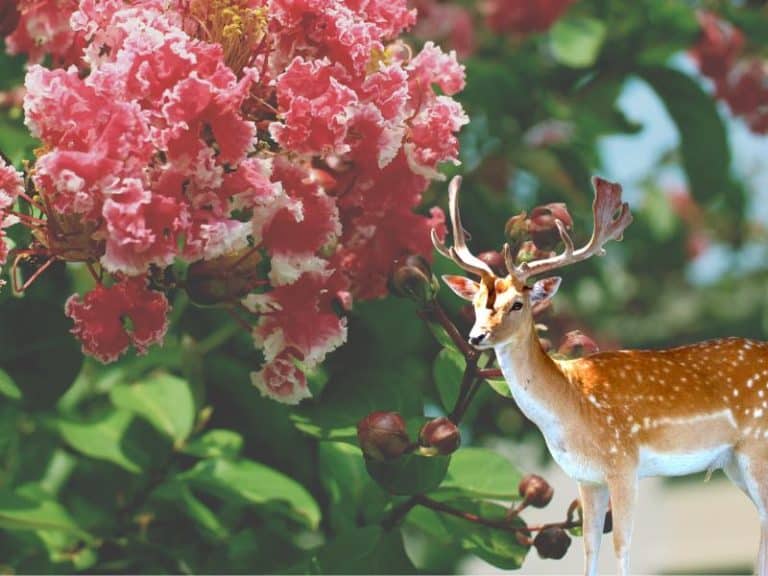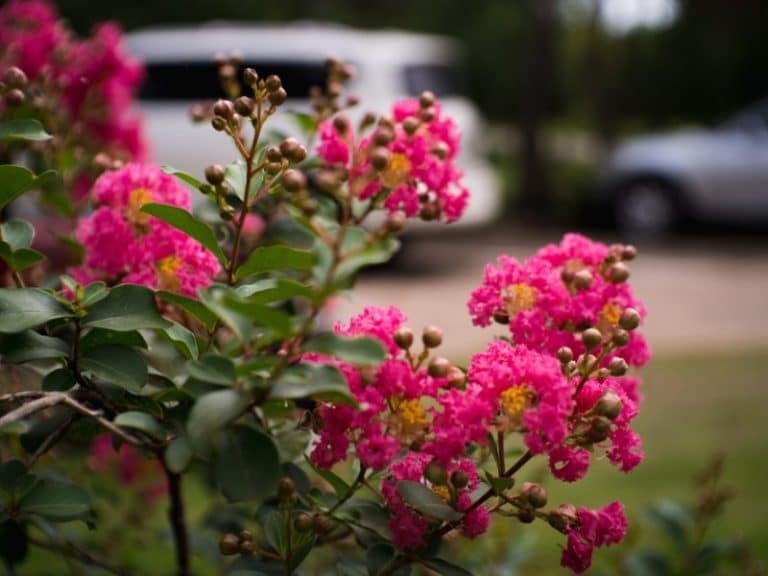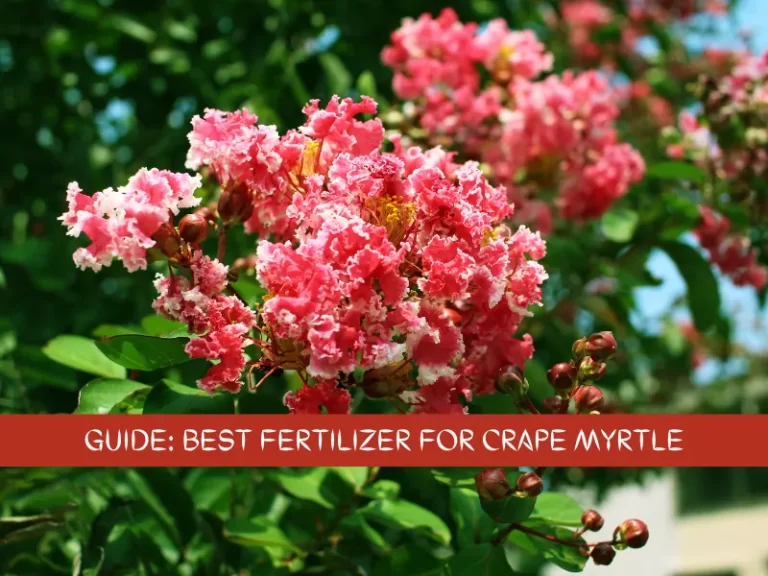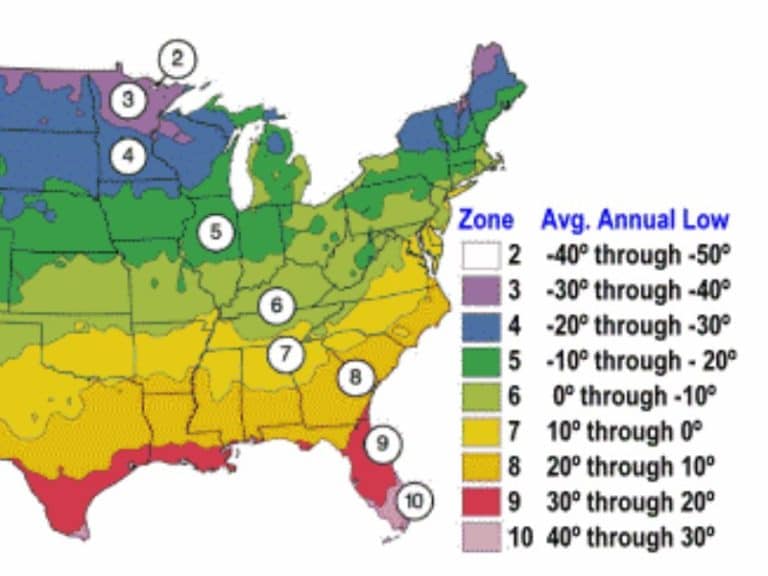Crape Myrtle Varieties (Pictures, Sizes and Colors)
Crape Myrtles are common landscaping trees, mostly used in privacy hedges, for hanging baskets, as bonsai, or even as beautiful specimen trees. There are over 52 varieties of crape myrtles, most with brilliant blooms and foliage.
This article discusses 14 common varieties of crape myrtle, covering their sizes, bloom colors and seasons.
Here are the most common types of crape myrtle:
1. Coral Magic Crape Myrtle
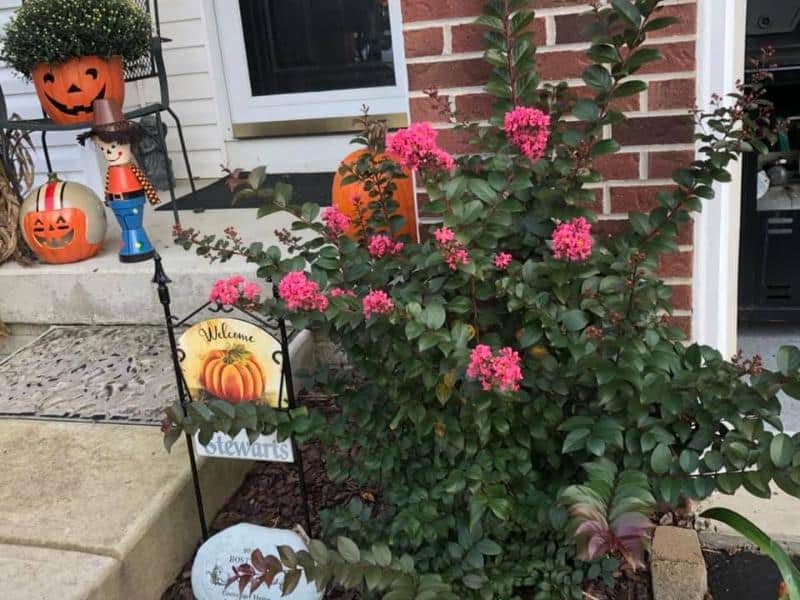
Coral magic crape myrtle is a class of plants within the Lythraceae family. It boasts showy blooms with coral-pink flowers. Coral magic crape myrtle grows upright, reaching 10 feet tall and spreading 8 feet wide with brilliant green foliage.
Coral magic crape myrtle, also known as Lagerstroemia ‘Coral Magic’, is a member of the crape myrtle family of trees and shrubs. The name originates from its vivid visually-alluring coral-pink blooms.
This deciduous shrub is native to China and Southeast Asia and was later distributed to Europe and the Americas. However, many cold-tolerant and disease-resistant hybrid cultivars have been developed over the years.
Size
Coral magic crape myrtle grows 8-10 feet high with a canopy between 6-8 feet wide at full maturity. Due to their relatively compact size compared to other varieties of crape myrtle, coral magic crape myrtles can be spaced as close as 72-96 inches apart.
Blooms and foliage
Coral magic crape myrtle develops several clusters of colorful pink flowers from early summer. You can also trigger a second bloom cycle in late summer by deadheading the spent flowers that sprouted during the first bloom.
| Names | Coral magic crape myrtle; Lagerstroemia ‘Coral Magic’ |
| Size | 8’-10’ tall, 6’-8’ spread |
| Soil type | Prefers well-draining soil but tolerates clay soil types |
| Soil pH | Withstands a wide pH range, including acidic, alkaline, and neutral soil. |
| Water | Moderate water requirements |
| Sun exposure | Prefers full sunlight exposure; can withstand partial shade |
| USDA Zones | Zones 7-9 |
| Bloom time | Early-late summer/early fall |
| Flower color | Salmon pink |
| When to prune | Late winter-early spring |
| Root system (type) | Shallow, fibrous roots |
Coral magic crape myrtle thrives in USDA hardiness zones 7-9. This includes the region from Maryland going south to Florida and Texas.
Cut off a few flowers in summer and prune the tree in winter to keep it blooming.
2. Delta Jazz Crape Myrtle
Delta Jazz crepe myrtle (Lagerstroemia ‘Delta Jazz’) is one of the newer crepe myrtle cultivars specifically bred to be more disease and pest-resistant. It can with drought while retaining its colorful red and burgundy appearance.
Origin and names
The common name for this crepe myrtle cultivar is Delta Jazz crape myrtle. However, it also goes by Lagerstroemia hybrid ‘Chocolate Mocha’ PP21540 or Lagerstroemia ‘Delta Jazz’.
The Southern Living Collection first introduced the Delta series crape myrtle was first introduced by the Southern Living Collection in 2010. Mississippi State University developed it as one of the first varieties with dark foliage.
Delta Jazz crepe myrtle is part of the ‘Delta’ series of crepe myrtle that also includes other well-known cultivars like Delta Flame, Delta Eclipse, and Delta Moonlight crape myrtles.
| Names | Delta Jazz crape myrtle; Lagerstroemia ‘Delta Jazz’; Lagerstroemia hybrid ‘Chocolate Mocha’ PP21540 |
| Size | Height: 8-12 feet; Spread: 4-6 feet |
| Soil type | Well-draining soil (chalk, loam, sand). Tolerates clay soil |
| Soil pH | Acidic, neutral, alkaline |
| Water | Moderate water needs (once per week during dry periods) |
| Sun exposure | Prefers full sunlight exposure, withstands partial shade |
| USDA Zones | 7a, 7b, 8a, 8b, 9a, 9b, 10a, 10b |
| Bloom time | Early-late summer (first bloom cycle)Late summer-early fall (second bloom cycle) |
| Flower color | Bubblegum pink/bright pink |
| When to prune | Late winter-early spring |
| Root system (type) | Fibrous and shallow |
Size
Delta Jazz crape myrtle has a dwarf-moderate height at full maturity, peaking at 8-12 feet tall and 4-6 feet wide.
Blooms and foliage
Lagerstroemia Delta Jazz produces vibrant, bubblegum pink flowers from mid-summer to early fall. Delta Jazz crepe myrtle will bloom vigorously during the first bloom but won’t have as many flowers during the rebloom.
Once the first batch of blooms is spent, you can deadhead them to force a second bloom that lasts late into fall.
Meanwhile, the dark burgundy leaves form a gorgeous backdrop for the colorful flowers. The foliage holds its rich color throughout the summer, even in southern states with scorching temperatures.
USDA hardiness zones
Delta Jazz crepe myrtle is well-adapted to the following USDA plant hardiness zones: 7a, 7b, 8a, 8b, 9a, 9b, 10a, and 10b.
3. Ebony Flame Crape Myrtle
Ebony flame crape myrtle (Lagerstroemia ‘Ebony Flame’) is a unique tree with black foliage and crimson red flowers. This new variety is revered for its fast growth, size potential, and pest and disease resistance.
Furthermore, it’s a multifunctional tree great for bordering since deer can’t browse it. Also, it’s a low-maintenance tree that’ll grow in well-drained soil.
| Names | Ebony flame crape myrtle; Lagerstroemia ‘Ebony Flame’ |
| Size | 10-12 feet tall; 8-foot spread |
| Soil type | Well-drained silt or loam; tolerates sandy and clay soil |
| Soil pH | 5.0-6.6 |
| Water | Minimal when established |
| Sun exposure | Full sunlight |
| USDA Zones | 7a, 7b, 8a, 8b, 9a, 9b, 10a, and 10b. |
| Bloom time | Early-late summer and late summer-mid fall |
| Flower color | Ruby red |
| When to prune | Late winter or early spring |
| Root system (type) | Fibrous and shallow roots |
Origin and names
Ebony flame crape myrtle is also called Lagerstroemia ‘Ebony Flame’. It’s part of the ebony series of crape myrtles, which also includes ebony fire, ebony embers, ebony glow, and ebony ivory crape myrtle cultivars.
This series was originally introduced under the name ‘Black Diamond crape Myrtle Series’ by the National Arboretum/US Department of Agriculture.
Size
Lagerstroemia Ebony Flame is classified as a mid-sized tree. It typically grows to 10-12 feet tall at full maturity, with a spread of 8 feet.
Blooms and foliage
From summer to fall, showy ruby-red blooms appear on the tips of the branches of Lagerstroemia Ebony Flame. The blooms occur as individual blooms in rounded clusters.
The foliage is a dark burgundy-black tone that creates a perfect background contrast against the red flowers. The branches grow upright to form a rounded canopy that gives Ebony Flame crape myrtle its distinctive, bushy shape and structure.
4. Midnight Magic Crape Myrtle
Midnight Magic crape myrtle works well as a compact shrub for hedges and tight spaces. Its most standout features are its ever-pink flowers that complement the purple foliage. It’s grown for its superior disease resistance compared to traditional crepe myrtle varieties.
Plant profile
| Names | Lagerstroemia ‘Midnight Magic’, Midnight Magic crape myrtle |
| Size | 4-6 feet tall (Dwarf variety) |
| Soil type | Well-drained loam soil |
| Soil pH | 6.0-6.5 |
| Water | Average |
| Sun exposure | Full sunlight exposure |
| USDA Zones | Zone 7, zone 8, and zone 9 |
| Bloom time | Summer and early fall |
| Flower color | Dark pink |
| When to prune | Late winter-early spring |
| Root system (type) | Shallow fibrous root system |
Origin and names
Lagerstroemia Midnight Magic is part of a new series of crape myrtle cultivars, including other ‘magic series’ cultivars such as coral magic and moonlight magic crape myrtles.
The ‘Midnight’ name is derived from the fact that its flowers are a dark shade of pink, while ‘Magic’ is the common name given to all cultivars within this series.
Size
Lagerstroemia Midnight Magic is a dwarf crape myrtle variety that only grows 4-6 feet tall at full maturity. The spread at full maturity is also within the 4-6 feet range.
As such, it’s grown as a rounded shrub, not as a tree.
Blooms and foliage
Midnight Magic crape myrtle produces numerous dark pink blooms from summer to early fall. It also boasts purple-maroon leaves that provide a great backdrop for the vivid pink flowers.
The foliage retains color, even in hot summers in the south, the foliage retains color into late fall before the crape myrtle goes dormant.
The blooming rate also varies, depending on your region. Midnight Magic crape myrtles grown in the south showcase more prolific blooming compared to similar varieties growing in the Pacific North West.
Note: You can deadhead the spent blossoms from the first bloom if you want a late summer rebloom. However, the second bloom cycle is not as vigorous as the first. There will be fewer blossoms.
Most Southerners favor this tree with noninvasive roots for its short stature and ability to make an excellent shrub near the home.
5. Pink Velour Crape Myrtle
The pink velour crape myrtle (Lagerstroemia ‘Pink Velour’) is a semi-dwarf cultivar commonly grown as a mixed shrub or solely for screening, hedging, or creating a focal point in the landscape. It has vibrant pink flowers and dramatically changing red-wine leaves.
It also has a high tolerance to drought and good resistance to powdery mildew.
| Names | Lagerstroemia indica ‘Whit III’, crape myrtle pink velour |
| Size | 6-10 feet tall, 6-10 feet wide |
| Soil type | Well-draining, loamy |
| Soil pH | 5.5-6.5 |
| Water | 1-2 times weekly |
| Sun exposure | Full sun |
| USDA Zones | 7, 8, 9 |
| Bloom time | Mid-summer to early fall |
| Flower color | Bright pink |
| When to prune | Late winter |
| Root system (type) | Fibrous |
Origin and names
The pink velour tree (Lagerstroemia indica) is a deciduous, flowering plant species native to south India and Korea. It belongs to the genus Lagerstroemia, consisting of 50 more plants and shrubs. The pink velour tree has naturalized in the southern regions of the U.S.
This plant can be grown as a small tree or shrub. It’s sometimes called Lagerstroemia indica ‘Whit III,’ crape myrtle pink velour, or Crapemyrtle Pink Velour
Size
A mature pink velour crape myrtle tree grows 6-10 feet tall and spreads between 6 and 10 feet wide.
Blooms and foliage
The pink velour crape myrtle blooms from mid-summer to early fall, and the vibrant colors stay long. The tree produces clusters of bright, pink flowers alongside deep, thick, wine-red, leathery leaves in mid-summer. The colorful flowers and foliages make the tree stand out among other plants in the landscape.
In late summer, the leaves slowly turn to purplish green and brownish-orange by fall. The bark of the tree also exfoliates, turning greyish-brown.
After the blooming period, the plant produces tiny seeds in seedheads that stay around until winter.
The pink velour crape myrtle requires minimal maintenance, provided it’s grown in its hardiness zone. Plant the tree in a location with full sun exposure and well-draining soil. Once established, water it moderately and feed it in summer for a healthy plant.
6. Purple Magic Crape Myrtle
Purple Magic (Lagerstroemia ‘Purple Magic’) is a prevalent crape myrtle species in the Southern states. It is known for its vibrant purple flowers blended with red-tinted foliage, dramatically changing to waxy green in summer. The purple magic crape myrtle has excellent resistance to powdery mildew, leaf spot disease, and deer.
| Names | Lagerstroemia’ purple magic’, the lilac of the south |
| Size | 6-10 feet tall, 6-10 feet wide |
| Soil type | Well draining |
| Soil pH | 5.0-6.5 |
| Water | Moderate |
| Sun exposure | Full sun |
| USDA zones | 6, 7, 8, 9 |
| Bloom time | Summer |
| Flower color | Purple |
| When to prune | Late winter or late spring |
| Root system (type) | Shallow fibrous roots |
Origin and names
The crape myrtle is native to Southeast Asia, China, and Japan, and is among the magic series of crape myrtles developed in the 1960s for improved cold-hardiness and disease resistance.
These varieties have naturalized in the southern states of the USA. Due to its color and popularity in the South, the purple magic crape myrtle is also known as the lilac of the South.
Size
Purple Magic is a semi-dwarf variety of crape myrtle plants. It grows primarily as a rounded shrub, dense on the sides and fuller in shape. A mature purple magic shrub grows 6-10 feet tall with the same spread.
Blooms and foliage
The purple magic crape myrtle is a perfect shrub whose flowers stay around several weeks after blooming.
In early summer, the shrubs display vibrant, vivid purple flowers while the foliages appear tinted red. It exhibits deep purple flowers mid-summer, while the leaves gradually change to glossy green.
The flowers can stay around for the rest of the blooming season. However, reblooming can occur in late summer if deadhead flowers are pruned to produce fresher, magnificent purple flower clusters that attract hummingbirds, bees, and butterflies in summer.
7. Strawberry Dazzle Crape Myrtle
The Strawberry Dazzle (Lagerstroemia ‘Strawberry Dazzle’) is a semi-dwarf variety of the crape myrtle, making it an excellent choice for small gardens and potted plants. It is known for its showy neon-rose flowers, glossy green foliage, and resistance to powdery mildew, drought, heat, and deer.
See more deer-resistant crape myrtle varieties here.
| Names | Dwarf crape myrtle, strawberry dazzle crape myrtle, razzle dazzle crape myrtle, berry dazzle crape myrtle, Lagerstroemia berry dazzle |
| Size | 3-4 feet tall, 3-4 feet wide |
| Soil type | Moderately moist, well-draining |
| Soil pH | 5.5-7.0 |
| Water | Moderate |
| Sun exposure | Full sun |
| USDA zones | 6, 7, 8, 9 |
| Bloom time | Summer |
| Flower color | Hot pink or neon-rose |
| When to prune | Late winter to early fall |
| Root system (type) | Shallow fibrous roots |
The strawberry dazzle is native to Southeast Asia, India, and Japan and is often called the dwarf crape myrtle, razzle dazzle crape myrtle, or Lagerstroemia berry dazzle.
Blooms and foliage
The razzle dazzle crape myrtle blooms from early summer to later in the season. It displays brilliant, hot pink flower clusters in early summer, with deep burgundy foliage. ,
The foliage transitions to glossy green later in the season, while the blooms remain neon-rose throughout the season.
Deadhead pruning crape myrtle can encourage newer, prolonged blooms until fall.
8. Lavender Crape Myrtle
The Lavender crape myrtle (Lagerstroemia indica x ‘fauriei’) is a deciduous cultivar of the crape myrtle native to southeast Asia, India, and Japan. It was developed in the 1960s by the National Arboretum for species more resistant to drought and powdery mildew.
It is a cross of the Lagerstroemia fauriei and Lagerstroemia Indica, which is why its botanical name is Lagerstroemia indica x faueri ‘Muskogee’.
It’s also known as the Muskogee crape myrtle, Japanese crape myrtle, and Fauriei Hybrid crape myrtle.
| Names | Muskogee crape myrtle, Japanese crape myrtle, and Fauriei Hybrid crape myrtle. |
| Size | 20-30 feet tall, 15-20 feet high |
| Soil type | Moderately moist, well-draining |
| Soil pH | 5.5-6.5 |
| Water | Low to moderate |
| Sun exposure | Full sun |
| USDA zones | 6, 7, 8, 9 |
| Bloom time | Summer to early fall |
| Flower color | Lavender-pink |
| When to prune | Late winter |
| Root system (type) | Shallow fibrous roots |
Size
The Muskogee crape myrtle exists in tree form and grows between 20-30 feet tall. Its branches are denser and arched and form canopies about 15-20 feet wide.
Blooms and foliage
The Muskogee crape myrtle tree’s flowers, foliage, and barks are visually appealing, and their vibrant summer color portrays it as showy.
A mature lavender crape myrtle tree is known to have the longest blooming period – about 4 months, with flowers emerging in summer to early fall.
It produces soft lavender-pink flowers with long, glossy green leaves, which dramatically become reddish-orange in early fall. Meanwhile, the cinnamon-colored bark exfoliates to a grayish, shiny one during blooming.
The lavender crape myrtle is an excellent cultivar for open spaces. It has soft, unscented lavender flowers and glossy green leaves, which transit to reddish-orange in fall.
The tree is popularly known for its more prolonged blooming than most crape myrtle varieties.
The lavender is widely grown in masses, with its dense branches forming attractive canopies in the landscape. Established plants need little attention, with occasional watering and monthly feeding in summer to encourage prolific blooming.
Follow your maintenance routine with a balanced crape myrtle fertilizer such as a 10-10-10 or 8-8-8 NPK thriving tree.
9. Cherry Dazzle Crape Myrtle
The Cherry Dazzle (Lagerstroemia indica) is a flowering shrub that originates from the Himalayas, South China, and parts of the Korean Peninsula where it grows in the wild.
The species is also known by other names such as the Dwarf Crape Myrtle, Gama I, Red Rocket, and its botanical name (Lagerstroemia Indica)after Swedish botanist Magnus von Lagerstroem.
Size
Plant experts occasionally use the word “dwarf” when describing the cherry dazzle, but the plant is not exactly short.
A mature plant can reach an average height of 3.5 – 5ft and have a relative spread of about 5ft. Flowers grow in small clusters averaging about 4”- 6” per cluster.
The table below summarizes Cherry Dazzle’s profile.
| Names | Cherry Dazzle, Dwarf Crape Myrtle, Lagerstroemia Indica, crepe flower. |
| Size | Height: 5 ft, Spread: 5ft. |
| Soil type | Well-draining, fertile. |
| Soil pH | 5.5-7.5 |
| Water | Moderate |
| Sun exposure | Full sun to partial shade. |
| USDA Zones | 7-10 |
| Bloom time | Summer, Autumn |
| Flower color | Cherry Red |
| When to prune | Winter |
| Root system (type) | Shallow and fibrous |
Cherry Dazzle flowers typically appear during summer and can last through fall until the first frost to indicate the onset of winter. The plant has deciduous traits and experiences leaf fall during the autumn months through winter.
Most flowers also fall during this time of year, and the foliage turns from a glossy green to burgundy red before dropping.
Cherry Dazzle Crape Myrtles can tolerate adverse conditions like drought, pests, low temperatures, and different soils.
10. Tonto Crape Myrtle
The Tonto Crape Myrtle is a subspecies of the more popular crape myrtle native to parts of Eastern Asia including countries such as China, Korea, Japan, India, and parts of Oceania. Its botanical name is Lagerstroemia indica “Tonto” but it also shares names such as crape myrtle, tonto, crepe flower, etc.
The species is naturalized across different continents and regions with conditions similar to its native environment. US residents find the plants a welcome addition to their gardens, patio, and hedges considering their appealing look and minimal care requirements.
| Names | Lagerstroemia, Tonto, Crape Myrtle |
| Size | 8′-15′ Height, 6’-10’ Spread |
| Soil type | Chalk, Clay, Loam, Sand |
| Soil pH | 5-7 |
| Water | Moderate |
| Sun exposure | Full |
| USDA Zones | 6-9 |
| Bloom time | Summer |
| Flower color | Red-Pink |
| When to prune | Winter |
| Root system (type) | Fibrous |
Tonto crape myrtles are smaller than other crape myrtle varieties and have a moderate growth rate averaging 13-24’’ per year.
Mature trees reach an average height of 8’-15’ and a spread of 6’- 10’ depending on the prevailing growth conditions.
The plant produces flowers in large clusters averaging 6 inches in length. Its foliage features a simple leaf design, smooth margin, and an average 2-6 inches leaf size.
Blooms and foliage
Tonto crape myrtles produce attractive blooms every summer. The blooming season lasts 8-12 weeks, after which the flowers fall off. Tonto crape myrtles have a red-pink hue, but the shade may vary depending on the tree’s variety.
The plant also consists of dark-green foliage organized in an alternate pattern. Leaf color changes to yellow or red during the fall months. New foliage appears during the spring when external conditions favor active growth.
11. Dynamite Crape Myrtle
- Names: Lilac of the South, ‘Whit II’
- Size: 10 –15′ and a spread of 12–20′.
- Soil type: Well-drained soils
- Soil pH: 5.0 to 6.5
- Water: 1-2 times a week
- Sun exposure: Full sun
- USDA Zones: 7-9
- Bloom time: Midsummer – Early Fall
- Flower color: Fiery red/Orange-red
- When to prune: Late Winter
- Root system: Fibrous
The Dynamite Crape Myrtle (Lagerstroemia ‘Dynamite’) is a variety of the crape myrtle family native to China. The plant has other names such as the “Lilac of the South”, Dynamite crepe myrtle, etc.
This variety is a product of selective plant breeding by horticulture professor Dr. Carl Whitcomb of the University of Florida and Oklahoma State University. The species prefers growing in the south of the United States where conditions are close to those in its native environment.
Size
The Dynamite Crape Myrtle can reach considerable sizes under ideal conditions. A mature tree has an average height of 10 –15′ and a spread of 12–20′.
Some varieties branch out at a young age and have shrub-like features. Crape Myrtles have small leaves with a blade size of less than 2 in. Mature plants bloom to produce numerous flower clusters with an average size of 14 in. per cluster.
- Foliage: Young leaves have a vibrant dark-green color, but the hue changes from green to yellow, orange, or red during the fall months.
- Flowers: Common bloom colors for a Dynamite crape myrtle range from deep red, white, lavender, light, and dark pink.
12. Red Rocket Crape Myrtle
The colorful “Red Rocket” crape myrtle (Lagerstroemia ‘Red Rocket’) is native to China, Korea, Japan, and some parts of Oceania. Its botanical name is Lagerstroemia indica ‘Whit IV.
In the US, “Red Rocket” crape myrtles grow predominantly in the Southern states where conditions are more accommodating and similar to those in its native environment. The species grows best under subtropical conditions (but can also tolerate slightly warmer or cooler conditions).
| Names | Lagerstroemia, Red Rocket, Crape Myrtle |
| Soil type | Well-drained |
| Soil pH | 6.0 – 7.0 |
| Water | Average |
| Sun | Full Sun |
| USDA Zones | 7-9 |
| Bloom time | Summer |
| Flower color | Ruby-red |
| When to prune | Winter |
| Root system | Fibrous |
“Red rocket” crape myrtles can grow to considerable heights and spread depending on the variety and grower’s intent. Mature “Red Rocket” crapes have an average height of 8 ft and a spread of 6-7 ft but can grow to a height well above 15 ft if left unpruned.
- Red Rocket crapes have attractive ruby-red flowers that bloom during Summer to mid-fall, where the flowers and foliage drop as the weather becomes colder.
- The plant’s foliage has a dark-green color that turns bronze-red during fall. The leaves have a simple leaf shape, opposite pattern, and smooth margins.
- Newly planted trees take 2-5 years to mature.
13. Crape Myrtle Twilight
The crape myrtle is native to China, India, and other parts of Southeast Asia. It is also popular in other parts of the globe as ornamental plants. In the US, you are more likely to find similar species within the South or in USDA growing zones 7-10, where prevailing weather conditions favor their propagation.
| Names | Twilight Crape Myrtle, Crepeflower |
| Size | 25 feet tall, 15 feet spread |
| Soil type | Chalk, Clay, Loam, Sand |
| Soil pH | 5-6.5 |
| Water | Regular watering, |
| Sun exposure | Full sunlight |
| USDA Zones | 7-10 |
| Bloom time | Late spring to early summer. |
| Flower color | Purple |
| When to prune | Autumn to Winter |
| Roots | Fibrous |
The average growth rate of the Twilight crape myrtle is about 3-5 feet per year, with a mature tree reaching about 15-25 feet in height and 10-15 feet spread.
Twilight crape myrtle produces crinkly purple blooms at specific times of the year. The flowers often appear during late spring to early summer when they sometimes appear with a fuchsia-pink shade, depending on the plant’s variety. The flowers bloom for about 120 days before dropping to the ground.
Crape Myrtle Twilight thrives in nitrogen-rich soil despite being a big grower. It attracts pollinators with its all-summer bloom and bright blooms. Important care practices for your twilight crape myrtle include keeping the soil acidic and using a balanced fertilizer.
14. White Crape Myrtle
John McNair Davy allegedly discovered the White Crape Myrtle (Lagerstroemia ‘Early Bird White’) in 1998 in Florida among Lagerstroemia ‘Acoma’ seedlings. Later, it was added to the Southern Living Plant Collection. It got its reputation from its reblooming, brilliant white color, and compact upright growth habit.
Its name refers to the snowy white color of its flowers.
- Size: At full maturity, Lagerstroemia ‘Early bird white’ grows 5-8 feet tall, with a spread of 3-4 feet.
- Blooms: It produces vibrant white flowers multiple times a year. It can stay in bloom for between 100 and 120 days at its peak in summer. The blooms appear in the spring and last until early fall.
- Foliage: The lustrous green leaves form a gorgeous backdrop for the flowers, making this ornamental an outstanding landscape attraction in the spring and summer. Leaves often turn yellow in the fall, providing a different aesthetic that’s just as intriguing.
The Early Bird White crape myrtle is perfect as an accent plant around patios and decks or as a hedge plant since it repeatedly blooms for up to 120 days in summer.
In conclusion, crape myrtles are a diverse and beautiful group of plants that can add color and interest to any landscape. With so many varieties to choose from, there is sure to be a crape myrtle that is perfect for your home. When choosing a crape myrtle, be sure to consider the size of the plant, the color of the flowers, and the amount of sunlight it will need.


